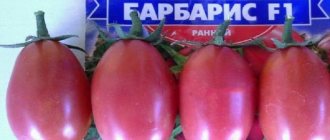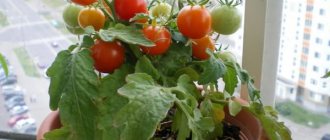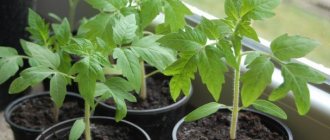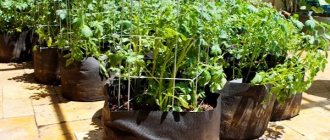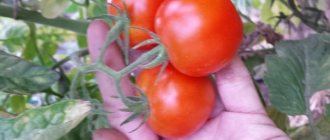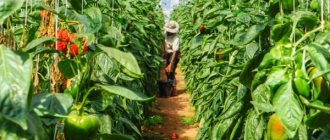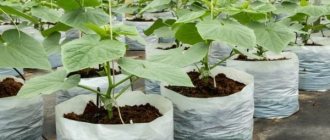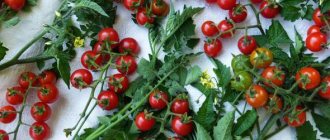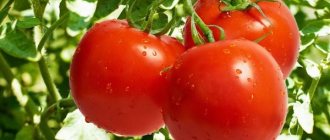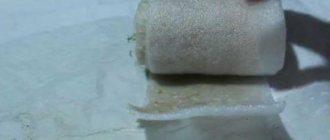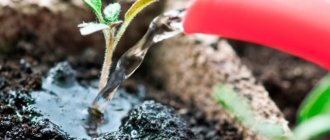The essence of the problem
Pinching is an agrotechnical measure in vegetable growing aimed at increasing productivity. It is intended for optimal development of the bush through its correct formation. The principle of the operation is to remove excess branches that do not bear fruit, but consume a certain amount of useful substances.
Tomatoes are one of those garden crops in which the bush begins to branch quite actively during development. As it grows, lateral branches appear from the axils of the leaves, which are considered useless elements that take away nutrients from the fruit. Such branches are usually called stepsons, and their removal is called stepsoning.
Thus, by solving the problem of how to properly plant tomatoes in a greenhouse or garden, you can ensure the correct formation of plants. Only fruit-bearing branches remain on the bush, which allows for more complete use of applied fertilizers and nutrients from the soil. The pinching scheme can be used in different ways, which makes it possible to form several variants of bushes.
Is it so important to remove unnecessary branches? This question can be heard from inexperienced vegetable growers. The need for the procedure can be assessed based on the following facts. Stepchildren on tomatoes grow between the stem and leaf. Their appearance causes the bush to actively branch, and new extra branches develop again and again. This phenomenon is especially noticeable in tall varieties (indeterminate tomatoes), in which a fruiting branch is formed only in the area of 7-11 leaves, and a stepson can develop from each leaf. In other words, for one useful branch there may be more than 6 useless ones.
As a result of the growth of the bush, the balance between the green and fruit mass is lost and the greens take over most of the nutrients. The ripening of fruits is significantly slowed down. Thus, it has been established that timely removal of stepsons accelerates the ripening of tomatoes by an average of 12-16 days. The fruits themselves on unplanted bushes are much smaller, and their total quantity is inferior to processed tomatoes. Finally, we can summarize - without pinching, there is a high risk of getting small, unripe tomatoes at the end of the season.
Principles of stepsoning
When carrying out pinching, it is important not to harm the plant, and for this, this operation must be carried out within a certain time frame and according to specific rules. Experienced vegetable growers give the following fundamental recommendations:
- The first planting of tomatoes in a greenhouse or garden should be done already on the first cluster during the flowering period.
- Tomato shoots must be picked in a timely manner before they grow to 5 cm. Branches can be removed by pinching, breaking off or tearing off, but not by cutting.
- All stepsons located below the branches with flower ovaries must be removed. If they are located above the flowering branch, then they can be left in anticipation of the possible appearance of ovaries.
- When tearing off the stepsons, you should try to ensure that the secreted juice does not get on your hands, because in this way you can infect other bushes with diseases present in the plant being treated. The event itself is best held in the morning.
- When pinching, it is necessary to remove the lowest leaves that touch the surface of the ground. The plant trunk should be dry, sunny and well ventilated.
- Secondary pinching with pinching of the top is provided in July-August to stop the growth of the bush upward.
Types of pinching
The question of how to shape tomatoes can be solved in three ways, depending on how many branches are left on the bush. The following types of pinching are distinguished:
- Scheme of 1 stem. With this method, all the stepsons must be removed, leaving only 1 stem for the fruit. The tomato grows quickly and the fruits become larger. The disadvantage is its large height, which requires tying it to a support, otherwise the stem will break under the weight of the fruit.
- Scheme with 2 stems. In this option, in addition to the main stem, 1 stepson is left on the bush, and the rest are removed. For fruiting, the strongest shoot is selected, usually located directly under the first inflorescence.
- Bush with 3 stems. This formation of tomatoes implies the preservation of the main stem and 2 stepsons. Pinching is carried out in this order: the strongest shoot is selected next to the lower inflorescence, and another fairly strong branch is found not far from it. All other stepsons are deleted.
Growing tomatoes in a greenhouse is most often achieved according to the first and second schemes. A three-branch bush is rarely formed in greenhouses. The question of how to plant tomatoes in open ground can be solved by any of the above methods, depending on the variety of vegetable.
The technology for planting tomatoes in open ground and in greenhouse conditions is no different. The initial operation is carried out when flower buds appear, until the shoots exceed a length of 4-5 cm. With a larger size of the torn off stepson, the likelihood of plant disease increases. It should be remembered that as the vegetable develops, new unnecessary branches appear and it is advisable to remove them every week.
Tomato care
Cherry tomatoes for growing in a greenhouse do not require much trouble. Caring for them includes the standard “set”: watering, loosening, and for interdominant varieties, also pinching. Watering is necessary regularly, but not abundantly. A lack of moisture leads to cracking of the fruit, and an excess affects the wateriness and taste.
Loosening improves air access to the roots and prevents them from rotting. Like ground tomatoes, those growing in a greenhouse are very sensitive to “rain” watering from a hose. Moreover, if this comes from a centralized water supply or a well. Cold water and high air temperatures have a detrimental effect on the bushes.
The best option is to water the roots with warm water, for example from a barrel, which it is advisable to place directly in the greenhouse. Unlike other types of tomatoes, cherry tomatoes must be tied up regardless of their size. This does not apply only to hanging varieties that are grown in a suspended state.
We suggest you read: How to place everything in a greenhouse
If in open areas the pollination process is carried out “naturally,” then in a greenhouse it is a human affair. There is nothing complicated: the brushes are slightly shaken. This causes pollen to spread to other flowers. It should be taken into account that the temperature should not be higher than 35 degrees and not lower than 12, the humidity should be no higher than 65%, and watering should be done after this operation no earlier than 2 hours later.
The pollination procedure is carried out 2 times a week. Cherries are fed in the same way as ordinary tomatoes. It’s difficult to do without chemicals, but manure was and is the best fertilizer. The solution is prepared as follows: manure is poured into the selected container and filled with water in a ratio of 1:10, mixed and left to ripen for 2-3 days, although the minimum is 1 day. Then dilute 1 liter in a bucket of water and add one liter at a time to the root.
For beginning gardeners, the question of how to care for cherry tomatoes is quite acute. Caring for tomatoes begins with organizing proper watering.
This variety does not tolerate drought, so if there is a long absence of moisture, the fruits will begin to crack and deteriorate. This means that the plants need to be watered daily. But at the same time, you need to monitor the level of moisture, since due to its excess, the bushes gradually begin to rot.
Cherry tomatoes also need to be tied up, because due to their own gravity, tomatoes growing on a branch can break it and fall to the ground.
Did you know? The weight of the tiniest cherry tomatoes does not exceed 10 grams.
Caring for sown seeds includes:
- Watering the soil with warm water immediately after planting the seeds (such a simple procedure will promote better germination).
- Thinning the sprouts after they reach 5-6 centimeters in height. If not all seeds have sprouted, then the procedure should be postponed.
- Regular loosening of the soil to provide air access to the seeds.
- Periodic fertilizing with complex mineral fertilizers (carried out once a week).
In the question “How to grow and care for cherry tomatoes after planting them?”, the main emphasis should be on watering and temperature control. Particular attention should be paid to this during the first three weeks after emergence. Daytime temperature should be 16... 18°C, and night temperature - 13... 15°C. This care should be continued until the second leaf appears on the sprout.
Cherry tomato seedlings should be watered directly at the root with warm water, the temperature of which should be 20 °C. Plants must also receive enough light. At the same time, it is necessary to regularly ventilate the greenhouse.
In order to grow a strong cherry tomato plant, especially the Fingers variety, you need to trim the top part of the plant. After shoots appear from the axils of the lower leaves, you will need to leave only the top 2 and remove the bottom ones. Thanks to this, the plant will form 2 shoots, which can then be tied to the trellis.
Caring for ripe tomatoes comes down to the following procedures:
- After the development of the fifth true leaf, cherry tomatoes are transferred to a new watering regime. Now the soil is moistened 3-4 times a week. The main thing is regular monitoring of moisture balance.
- Every 10–12 days you need to fertilize the tomatoes, alternating mineral and organic fertilizers. Just do not overdo it, since a high concentration of nutrients in the soil can lead to rapid growth of green mass, which will prevent the formation of new fruits.
- As the soil settles under the plant, it is necessary to gradually add a layer of fresh substrate.
- To ensure better pollination, it is necessary to gently shake flowering plants 2-3 times a week.
Separately, it is worth mentioning about planting cherry tomatoes. Tall bushes need shaping. To do this, you need to manually break off the stepsons, leaving only a stump 1.5–2 centimeters high. Due to this, the growth of the main shoots will be stimulated and the overall yield of the bush will increase.
After the plant has formed most of the ovaries, you should pinch the crown of the main stem and tear off the flowering brushes. Correctly carried out pinching will cause rapid ripening of the fruit. Thus, the question of how to plant cherry tomatoes can be considered closed.
Stepping depending on the variety
According to the growth pattern of the bush, all tomatoes are divided into 2 main types:
- Indeterminate varieties. These are quite tall plants in which the growth of the top is not limited. Side branches also grow quickly. If such bushes are not formed according to the chosen pattern and the tops are not pinched, then they reach great heights and grow significantly in all directions. All this happens to the detriment of the quantity and quality of the fruit.
- Determinate varieties. Their main difference from the previous variety is the limitation of the growth of the main stem. A fruiting vine forms at its top, which stops the plant from growing in height. Thus, the number of ovaries after the appearance of the upper inflorescence no longer increases, and therefore it is very important to correctly select the most fertile branch.
The question of how to pick off stepchildren can be answered as follows: different varieties require a specific approach, taking into account the characteristics of their natural formation. Indeterminate tomatoes can be planted using any pattern, but the 1-stem pattern is most often used. It is important to pinch tomatoes in the greenhouse (the top) in a timely manner to prevent excessive growth in height.
When growing in a greenhouse and using a 1-stem scheme, this technology is usually used. The remaining stem, as it grows, gradually descends to the ground and is laid on its surface. New stepsons that appear are constantly removed. 8-10 clusters are left on the main stems. The most common varieties are Major, Schastie, Sprut.
The formation of determinate tomatoes poses certain difficulties. To correctly select the highest quality stem, it is recommended to adhere to the following principles:
- the most commonly used scheme is with 2 or 3 stems;
- the stepsons break off when they reach a length of about 4 cm, when their viability can be assessed;
- if there is doubt about the correctness of the choice, then it is better to temporarily leave several branches and remove unnecessary ones after the start of flowering;
- when growing in open ground, it is possible to do without pinching, since the bushes can be placed at a sufficient distance from each other;
- 6-8 inflorescences remain on the remaining stem.
Planting seedlings
The time for planting seedlings varies from February to April, although practice shows that in hot climates it can also be grown without seedlings in greenhouses. The fruits ripen completely. It is best to take a ready-made store-bought substrate for seedlings. It has optimal nutrient content. If there is none, you need to prepare it yourself, paying attention to the type and acidity of the soil.
It is advisable to calcinate it in order to protect the seedlings from root-gnawing pests. Soil is poured into the prepared containers. The grooves are made at a distance of 6-7 cm from each other, and between the seeds - 2-2.5 cm. The depth is just over a centimeter. Next, the soil is moistened and placed in a warm, well-lit place and covered with film or glass.
We suggest you read: Eggplant leaves curl - what to do
It is important to place the container on a stand so that air has access to the roots. When seedlings appear, a temperature of 15-18 degrees is required for 7 days. Subsequently, it is raised to 20. Every day, the plants must be turned with the other side towards the light: this way one-sidedness can be avoided. Watering is done only twice until 2-3 true leaves appear.
Carrying out stepsoning
Removal of stepsons is usually achieved by hand without the use of a cutting tool. When using knives, there is a risk of transferring infection from one bush to another and causing a wound at the cut site. However, with a large greenhouse farm it is impossible to do without tools. In principle, you can cut off the stepsons, but with precautions.
Before growing tomatoes in a greenhouse (step by step) by cutting, you need to remember the following:
- The tool is sharpened to a razor sharp state.
- The cutting part is disinfected with a solution of bleach or potassium permanganate.
- With a quick and precise movement, the stepson is cut at a distance of 10-15 mm from the base, without damaging the main branch.
- All the shoots on one bush are cut off, and the removed stems are immediately placed in a separate container and taken out of the greenhouse, which avoids rotting and the spread of infection.
- New instrument disinfection is necessary. This operation is carried out every time you move to a new bush.
When providing the necessary care for tomatoes, it is important to clearly distinguish the stepson from the fruiting stem. The following are the most important differences:
- leaves are immediately noticeable on the stepson, while flower ovaries are visible on the stem;
- the stepson grows from the leaf axil, and the fruiting vine branches only from the stem;
- the most obvious difference is when the length of the stepson is about 4-5 cm.
Pinching is rightly considered an important agrotechnical measure when growing tomatoes both in greenhouses and in the garden. This simple but painstaking work requires extreme care and caution, but the stepson tomato produces a bountiful harvest and tasty, full-fledged fruits.
Growing Cherry tomatoes
Author: Rostislav Malyavko
Good afternoon friends! Glad to see you on the pages of my blog!
To plant or not to plant tomatoes? An eternal debate among gardeners and gardeners. Some argue that by giving up pinching, they increase productivity. Their opponents are confident that if the growth of tomatoes is not limited, late blight will definitely eat them, and the fruits will still not have time to ripen. I think that both are right in their own way. Planting tomatoes is necessary in regions with short or cool summers and depends on each specific variety. Today I want to tell you about growing cherry tomatoes, the features and subtleties of this process. Don’t forget that our goal is to grow a crop, and not just grow it!
Let me start with the fact that before you run to the garden bed and break off the side shoots, it is advisable to study this issue in more detail, because if you pinch it incorrectly, you can get a very beautiful bush that will decorate your garden bed, but there will be no fruit on it. Let me start with the fact that cherry tomatoes, as a separate type of tomato, appeared not so long ago, but with their taste and extremely decorative appearance, they have earned the recognition and love of many gardeners and farmers.
It has many advantages: taste, attractive appearance of the fruit, shelf life, transportability.
Also, loved by lovers of indoor flowers. Such varieties as Cherry Lycopa, Thumbelina, Malyutka, and Bonsai look extremely decorative on the windowsill.
Not all cherry varieties have side shoots removed. For example, varieties intended for home or balcony cultivation are not planted.
These are the so-called standard and determinate varieties. For them, each side shoot ends in a brush, and the bushes themselves are low. These include varieties Minibel, Cherry-Mio, Balcony Miracle and others.
On the street
It is worth talking in more detail about the growing of indeterminate Cherry varieties, of which a huge number have been selected, for every color, taste and size.
If tomatoes are grown in open ground, and the summer is warm and long, you can do without pinching, but you will have to take into account the strength of each specific bush and the area it occupies. Cherries are characterized by increased fruiting, so if the bush is weakened, then some of the side shoots will still have to be removed, otherwise, due to the abundance of fruits, the bush may dry out.
If the bush is strong, healthy, and the area of the plot allows, you can form a bush with at least ten trunks. The main thing is not to get carried away and not to allow the garden bed to become crowded, otherwise you may miss the onset of the development of late blight, to which all tomatoes are prone.
Whatever your decision, remember that the bed or row with tomatoes must be well blown by the wind and illuminated by the sun, then you will get the harvest you dream of.
If you decide not to plant tomatoes, increase the distance between the bushes to the maximum.
Correct stepsoning
In order to get a harvest in short and cool summer conditions, it is best to form one or two trunks of indeterminate varieties. Cherries are characterized by increased shoot formation; if this is not done, the fruits will not have time to ripen. The peculiarity of Cherry tomatoes is that when picked unripe, the fruits lose all their taste, although the appearance remains beautiful.
The most important thing to do first is tie the bush to a support. Many people make trellises. Then, as it grows, every shoot you left behind is attached. If you are growing a bush with several trunks, you will need to tie each one. One of the disadvantages of this type of tomato is the thin stem, which without support easily breaks due to the abundant harvest.
When removing a side shoot, leave part of it, do not cut it under the trunk, otherwise a new one will very quickly grow in its place.
Pruning is best done in cool, rainy weather. At this time, the stepsons become fragile and break off easily. And the plant heals wounds much easier. In hot climates, this procedure should be carried out early in the morning or after sunset.
A month before the cold weather, pinch the top of the bush to stop its growth. This action will speed up the ripening of the remaining fruits.
How to pinch tomatoes
Improperly pinching tomatoes will result in a lush and spreading bush of a plant with a meager harvest. And tomatoes are usually grown not to decorate a flower bed, but to enjoy the delicious fruits.
Pinching is done only after the flowers of the upper inflorescence have opened, while several leaves are always left above it, which will supply the fruits with nutrients. When forming a bush into two stems, leave the main one and allow one of the side ones to develop. On the main stem, 4-5 clusters are left to bear fruit, then after flowering ends, the top is pinched off. 2-4 brushes are left on the side stem and the top is also pinched.
Growing Cherry in closed ground
Growing Cherry tomatoes in a greenhouse very much depends on the variety. The fact is that these tomatoes, or rather some of them, indeterminate varieties, grow up to 3 meters, and with good care, bear fruit within six months. All this time, they are actively bushing.
Such determinant Cherry varieties as Ampelny, IzyumF1 do well without pinching.
In the greenhouse, tomatoes begin to take steps when the plant has formed into an adult bush and the first ovary has appeared. Excess shoots are removed to speed up the ripening of the crop. In addition, it is worth pinching the top of the bush a month before the end of harvest.
Honestly, caring for this type of tomato is not much different from all the others. Once again I will draw your attention to the main points.
- The shorter the summer, the more stepsons are removed to speed up the ripening of the crop. In such conditions, it is best to leave one or two trunks and not allow the bush to grow green mass. In the middle zone, you can leave up to 5 trunks in a greenhouse.
- Be sure to tie up the cherry tomatoes, otherwise they may break or fall to the ground.
- Stepchildren are removed once every 5-6 days, but again the timing may vary, depending on the chosen variety.
- Break off the side shoots carefully, leaving a small stump. Be careful not to damage the main stem.
- Low-growing cherry tomatoes do not need to be pinched, and tomatoes intended for indoor growing, especially, do not need to be pinched. Each side shoot ends in a brush.
That's probably all I wanted to tell you about Cherry tomatoes. I hope you enjoyed reading and discovered something new for yourself. Share the article with your friends and acquaintances. Write in the comments how you care for this variety of tomatoes.
Also take part in a competition on the blog and win valuable prizes!
Best regards, Rostislav Malyavko!
This article is worth sharing with friends. Press!
Planting in a greenhouse
An important factor in a good harvest is the location of the greenhouse itself. Tomatoes are sun-loving plants, so shading can have a negative impact on them. Planting ready-made seedlings depends not only on soil temperature and climatic conditions, but also on the variety and the desire of the gardener to obtain a harvest for as long as possible. The soil temperature should not be lower than +15°C. If desired, it is measured with an ordinary household thermometer, leaving it in the soil for 20 minutes. (It is best to take measurements early in the morning, since the ground is coldest at this time). During planting, the two lower leaves are removed and the plant is buried to this level. Watering is carried out no earlier than 12-14 days after planting. Planting scheme for low-growing plants: 40 cm between bushes and 45 cm between rows. For tall people: 50 and 75 cm, respectively. For convenience during further processing, it is recommended to plant tomatoes in a checkerboard pattern.
Types of cherry tomatoes
They are divided into technical and table or salad varieties. Salads are divided into the following groups:
- Cocktail – 3-4 cm in size, delicious, can be vegetable and fruit;
- Cherry - 2 times smaller in size than cocktail tomatoes, but they are sweeter, these tomatoes are the sweetest in the entire group;
- Kleisters are clusters with small tomatoes, all the fruits ripen at the same time;
- Currant-shaped - they have more qualities of a wild tomato compared to others, which is where the name of the group comes from; they do not exceed the size of a large currant berry.
In all groups of small-fruited tomatoes, except for currants, tomatoes have different tastes, shapes and colors. They range in size from giants (up to 3 meters high) to tiny ones that have enough space in a flower pot.
Do side shoots need to be removed?
Certainly! Pinching is an integral technique in tomato cultivation. Allows you to direct all nutrients - organic matter and minerals - to the ripening of tomatoes. On numerous clusters with an abundance of fruit, all the crumb tomatoes have time to set and turn red before the harvest is released.
For earlier and more productive harvests, this technique is necessary. It is carried out regularly once every 7-10 days.
Taking into account the recommendations regarding the variety, the optimal management scheme is chosen - 1, 2 or 3 shoots.
Rules for formation and stepsoning
The formation of such varieties requires regulating the number of fruits by pinching extra shoots. Shoots on this plant appear in all leaf axils. They are removed, leaving a stump no more than 3 cm long. Thin out the tomato bush after the fruits begin to ripen. To do this, they tear off all the leaves located under the brush and do this work in several stages. Removing the growing point on the main shoot (also called pinching) is necessary so that all the fruits have enough time to fully form and ripen. The shoots are pinched a month before the temperature drops below 8 degrees Celsius.
The planting of tomatoes differs among different varieties, but there are common features that are also taken into account:
- These tomatoes grow many stepsons; for this reason, stepsons are regularly carried out;
- The yield of small greenhouse tomatoes from one bush is lower than that of their counterparts with large fruits, but this pays off with an extraordinary taste; when choosing a format, you need to remember this, in addition, per square meter, you can plant more bushes than large-fruited tomatoes;
- Their stems are much thinner than those of conventional varieties. There are liana-shaped forms, they need to be tied up, trellises are installed more often than for other tomatoes;
- The bush of these tomatoes can bear fruit for six months if it grows in favorable conditions.
In protected structures you can plant them earlier than outside, and in such conditions they will produce their last fruits much later than ordinary tomatoes.
Low growing tomatoes
They are considered a determinant species. For this reason, plants form like other determinants. Among these varieties, there is a separate group with very small bushes. They are similar to standard varieties and, in fact, are very close to them. Up to 3 clusters are formed on the main stem; the stepsons almost do not grow.
Pinching is not needed for these babies. These varieties are unable to grow many fruits, but the fruits ripen very early; some varieties can produce the first harvest within 3 months.
The next type is real determinants, their height is within 0.5-1 meter. These varieties form, just like determinate tomatoes with large fruits, in this way:
- One escape. Cherry tomato planting must be carried out completely. After this, the ovaries appear only on the main shoot. Tomatoes ripen early with this formation, but few fruits can be grown;
- Two escapes. One trunk is left - the main stem, and as an additional one - a developed stepson that appears below the first cluster. The formation of cherry tomatoes is carried out when the third flower cluster appears; at least 2 leaves must be left above the second shoot;
- Three escapes. In the hot season, they are also grown in three stems, leaving as the third the stepson that appears above the first cluster.
An example of the formation of plants with 1, 2 and 3 shoots.
Several productive varieties need to be mentioned:
- Irishka F1. Cocktail variety, bears early red fruits. Height is about 60 cm, pinching should leave a moderate number of stepsons;
- Honey candy F1. Mid-season hybrid, bears orange fruits in the form of cream. The plant grows up to one meter in height; bushes with 2-3 stems can be formed;
- Blossam F1. Mid-season hybrid, bears red, round fruits. The plant is about a meter tall, the bush grows strong, formed into 2 shoots.
Medium height cherry tomatoes
These varieties are prone to ending the growth of the main shoot too early, the so-called topping. They must be formed into 1 or 2 shoots, but it is necessary to leave spare stepsons, which will be useful during the early termination of the main stem. The reserve stepson must be left under all the emerging brushes, leaving a new reserve stepson, break out the one left earlier.
Rules for formation and stepsoning
Forming a cherry tomato bush allows you to conveniently regulate the load. To do this, remove excess shoots and pinch out the shoots. All cherries must be fixed to a support or trellis due to the thinness of the stems.
How to properly plant tomatoes in open ground:
- stepsons are removed until they exceed 4-5 cm in length;
- leave a stump no longer than 2-3 cm;
- the bush is lightened only from the moment the brush ripens;
- pinch the top of the trunk.
How to form in open ground:
- if there are more brushes on the main stem, and this happens with determinants, leave it as the main one;
- retain most of the leaves;
- pinch the growth point so that all the brushes have time to mature together.
Low growing tomatoes
All are determinants. Description:
- grow in the form of compact bushes up to 20-30 cm in height;
- included in the standard group;
- on the main trunk the number of brushes is within 3;
- form few stepchildren;
- The shoots practically do not branch.
How to process tomatoes in a greenhouse step by step:
- In 1 stem. Absolutely all stepsons are removed. Harvest is produced only by brushes on the main shoot. Ripening begins 10-14 days earlier. The disadvantage is a 10-20% reduction in productivity.
- In 2 barrels. There are 2 main shoots. There are stepsons before the first bunch. Pinching is carried out only after tying the 3rd brush, over which 2 leaves are passed.
- In 3 stems. This method is most often used when cultivating tomatoes in Crimea, Krasnodar, Sochi and other hot regions. With this option, the third stepson will be located above the 1st fruitful bunch.
Medium height bushes
The length of the stems varies from 90 cm to 1.4 m. Medium-sized tomatoes bear fruit well in greenhouse conditions.
They are characterized by:
- early completion of growth of the main trunk;
- formation into 1-2 stems.
Popular varieties and hybrids:
- Pink jumper,
- Date red,
- Date yellow.
Such auxiliary stepchildren are needed under each new brush. The previous ones are deleted.
Tall varieties
Characterized by uncontrolled vegetative growth. The length of the shoots reaches 2-3 m.
What forming is carried out:
- 1-2 stems - the most common method;
- in 3-4 trunks in the southern territories, where summers are warm and long.
The group is the most numerous. The following options are especially appreciated:
a brief description of
Cherry varieties and hybrids tend to have an abundance of green biomass. They form many stepchildren. Therefore, pinching during their cultivation is an important operation. Thanks to it, all the tiny fruits on the bunches have time to ripen almost simultaneously. This is important for harvesting in clusters.
In greenhouses and at home, fruiting can last up to 6-7 months! An important condition is shaping and feeding.
Cherry trunks are thinner, often liana-shaped, and require fixation. The garter is carried out simultaneously with pinching.

